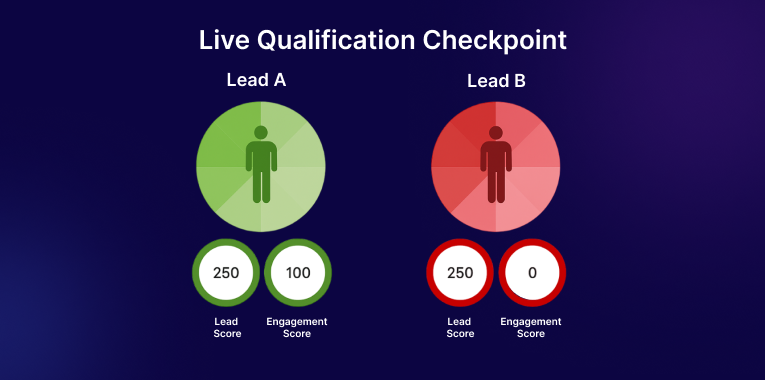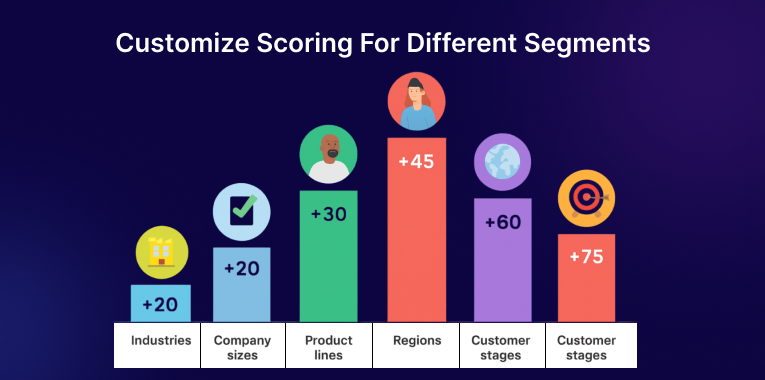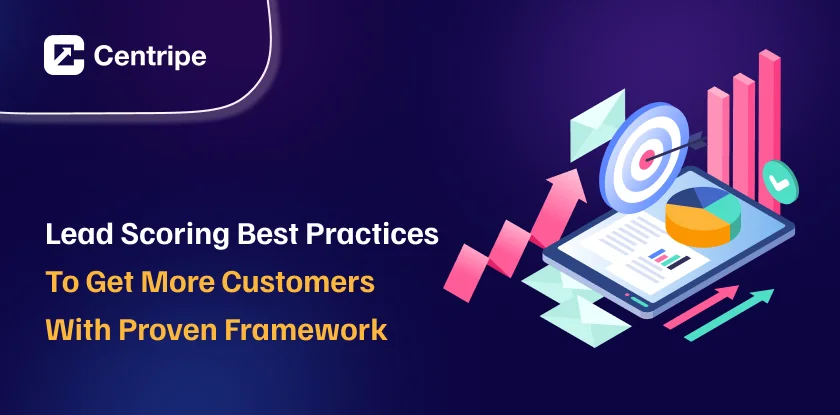Still treating every inquiry like it’s 2010?
But… that won’t work anymore.
That’s where….
Lead scoring best practices help you focus on the most valuable leads that are worth pursuing.
In fact, companies that follow the right approach typically see a 38% improvement in lead-to-conversion rates.
Let’s see those simple yet impactful tactics.
What Is Lead Scoring & Why It’s Important?
Lead Scoring is basically a way to assign numerical values to your prospects based on who they are and what they do. In a more simple language, it is your systematic answer to that age-old sales question: ‘‘Which leads should I call first?’’
There are two types of data here:
- Explicit Stuff (company size, job title, industry)
- Implicit Signals (email opens, content downloads, website visits)
Mix them together with proper lead scoring best practices and get an objective framework for prioritizing prospects.
Comparison Table: Traditional vs. Predictive Lead Scoring
| Factor | Traditional scoring | Predictive scoring |
|---|---|---|
| Setup Time | 1-2 weeks | 2-3 months |
| Minimum Data required | 100 Leads | 1,000+ closed deals |
| Accuracy | 60-70% | 80-90% |
| Transparency | High | Low to Medium |
| Cost | Low | High |
| Maintenance | Weekly/Monthly | Quarterly |
| Best Use case | < 500 leads/month | 500+ leads/month |
10 Lead Scoring Best Practices That Actually Work

To derive the full value from the leads, you need a scoring system that aligns with your business objectives. Use the effective practices to rank leads wisely.
Here are the best practices to do it right.
1. Design a Holistic Process:
To get the best results with lead scoring, don’t do it in random pieces. Build a complete end-to-end lead management process that your team can automate, track, and improve over time.
You need to map out everything:
- Data collection: Where’s your info coming from?
- Score calculation: Who’s doing the math and where?
- Threshold management: Who decides what’s “qualified”?
- Lead routing: How do hot leads get to sales?
- Feedback loops: How does sales tell you if your scoring sucks?
- Reporting: Who sees what metrics and when?
Without these basics, even Einstein’s scoring model won’t work well.
2. Collaborate with Sales to Define “Sales-Ready”:
This best practice ensures that both sales and marketing teams work together to decide when a lead is truly ready for sales.
Get in a room (or Zoom) with your sales team regularly:
- Look closely at recent sales wins (what did those leads have in common?)
- Review lost deals (what warning signs did we miss?)
- Clearly decide when marketing should pass leads to sales.
- Agree on how fast sales should respond.
- Create a shared definition of “quality” that everyone buys into
- Set up weekly check-ins for the first month
Trust me, this alignment is worth its weight in closed deals.
3. Balance Explicit and Implicit Criteria (The 60/40 Rule):
This best practice says to give more importance to what leads do (behavior), about 60% and less to who they are (demographics fit), about 40%.
Why? Because actions show real buying interest.
Just because someone has a fancy job title doesn’t mean they’re serious about buying. The one who’s clicking, watching, and downloading is the one who is ready to buy, even if they have a smaller title job.
4. Implement Dynamic Negative Score:
Leads lose interest over time, so their scores should go down if they become inactive.
- Subtract 5 points if no response after 14 days
- Subtract 10 points after 30 days of silence
- Subtract 20 points after 60 days with no activity
- After 90 days with no contact, reset the lead score to zero.
Exception: For enterprise leads, you can use longer periods (6-12-month cycles)
This way, your sales team focuses on warm, active leads instead of wasting time on old and inactive ones.
5. Include Live Qualification Checkpoints:

One of the most crucial practices is ‘live qualification checkpoints’. Why? As, lead scoring tools are helpful, but they can’t do everything, so you still need to add a human touch.
That’s where your inside sales team or SDRs come in. Before handing a lead to sales, they should do a quick live check.
This approach really boosts your sales acceptance rate by 20-40%.
The live qualification process typically includes:
- Does the lead fit your ideal customers?
- Are they actually interested in buying?
- Is their contact info valid?
- Are they open to talking to a salesperson?
In our experience, about 35% of leads look good on paper, but aren’t ready when checked live. This gets better as your scoring model improves.
6. Automate Actions Based on Score Thresholds:
Set up automatic actions based on lead scores so no leads are missed, even when salespeople are busy or away.
- 0-25 points: Send a Welcome email and add them to a general nurturing campaign.
- 26-50 points: Share product information that fits their industry.
- 51-75 points: Notify Sales to keep an eye on these leads.
- 76-99 points: Have an SDR call the lead within 24 hours.
- 100+ points: Send the lead straight to the Account Executive within 2 hours; they are a top priority.
Automation like this ensures every lead gets the right attention at the right time, no matter what.
7. Measure What Actually Matters:
To improve lead scoring, you need to track the right numbers. Use these lead scoring measurement tips to stay on target:
- Lead-to MQL conversion rate: Are you finding enough good leads? (Aim for: 20-30%)
- MQL-to-SQL conversion rate: Are the salespeople happy with the leads we send them? (Target: 60-80%)
- SQL-to-opportunity rate: Do accepted leads turn into real deals? (Expect: 50-70%)
- Average deal size by score range: Do leads with higher scores bring bigger checks?
- False positive rate: How often do you mistakenly flag unqualified leads? (Keep it under: 20%)
- Score distribution: Are most leads bunched in the middle? (Bell curve = good)
Note: These measurements help us see if we are finding the right people to talk to within your lead management system.
8. Customize Scoring for Different Segments:

Don’t use one scoring system for every type of lead; what works for one group might not work for others.
Create different scoring models for:
- Industries: Healthcare leads care about HIPAA; retailers want inventory features
- Company sizes: Enterprise buyers act nothing like small ones.
- Product lines: People interested in different products have different behaviors.
- Regions: Leads from different parts of the world often have unique habits.
- Customer stages: New customers vs. existing customers need different scoring.
- Buying committees: Technical people might care about features, while business people look for value.
Although this strategy takes more effort. But it’s worth it. This is the kind of lead scoring move that separates serious teams from the rest.
9. Regularly Audit Your Model:
Setting a lead score is not just a one-time task, it is something you keep improving as you learn what works best.
Use reports to see if you’re qualifying leads too early or too late:
- If leads get stuck between marketing and sales, Optimize: how fast leads are passed.
- If leads don’t move forward after sales get them, Optimize: the sales-ready score to send only better leads.
Make sure to regularly watch below numbers:
- SAL rate (how many leads are accepted by sales)
- Lead response time
- SAL to SQL speed (how fast leads become opportunities)
- Lead recycle rate (lead sent back for nurturing)
- Lead Leakage rate (how many leads dropped out and went nowhere)
As your lead scoring gets better, your marketing campaign will also have a higher ROI, meaning you’ll get more sales for the same amount of effort.
10. Choose Technology That Scales:
Last, but one of the best ways to improve lead scoring is to use the ‘right technology’. They help you manage and use lead information more easily.
For example, A good CRM like Centripe helps you track lead details, score them automatically using your lead scoring models, and assign them to the right team.
Conclusion
Many team treats lead scoring as ‘go with the flow’ with no clear plan. That leads to wasted time, missed leads, and a lot of confusion.
But.. it doesn’t have to be that way.
And that’s the point of the above lead scoring best practices, so you can finally bring order to your lead process.
So, use this 2025 plan to stop confusion and start targeting the right leads with confidence.
